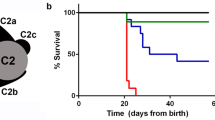Summary
When homozygous the recessive, pleiotropic, mutationhpy (hydrocephalic-polydactyl) produces post-natal hydrocephalus, complete sterility in males, and reduced reproductive performance in females. Because the fertility problems and the development of hydrocephalus could arise as consequences of defective flagella and ciliary axonemes, this mutant type might serve as a useful animal model for the immotile cilia syndrome. Ultrastructural defects seen in axonemes of flagella, and of cilia from the trachea, oviduct, and ependyma included: a deficiency of inner dynein arms (the most frequent defect); an absence of one or both central-pair tubules; extra central tubules; a displacement of one outer doublet and/or the central-pair tubules. Some axonemes showed more than one of these defects. The frequency of dynein-deficient axonemes in all three tissues was similar (about 35%) and fell within the range reported for human patients with the immotile cilia syndrome. On this basis, this mutant type might be considered as a useful animal model for such studies. There were no indications of situs inversus, nor was there a marked increase in respiratory problems. Sohpy/hpy mice do not exhibit all of the clinical symptons characteristic of the human condition.
Similar content being viewed by others
References
Afzelius BA (1976) A human syndrome caused by immotile cilia. Science 193:317–319
Afzelius BA (1979) The immotile cilia syndrome and other ciliary diseases. Int Rev Exp Pathol 19:1–43
Afzelius BA (1981a) Genetic disorders of cilia. In: Schweiger HG (ed) International cell biology 1980–1981. Springer, Berlin Heidelberg New York, pp 440–447
Afzelius BA (1981b) “Immotile-cilia” syndrome and ciliary abnormalities induced by infection and injury. Am Rev Resp Dis 124:107–109
Afzelius BA, Eliasson R (1979) Flagellar mutants in man: on the heterogeneity of the immotile-cilia syndrome. J Ultrastruct Res 69:43–52
Ailsby RL, Ghadially FN (1973) Atypical cilia in human bronchial mucosa. J Pathol 109:75–78
Albegger KW (1978) Zilsienveränderungen bei chronischer sinusitis maxillaris. Eine rasterund transmissionselektronenmikroskopische Untersuchung. Laryngol Rhinol Otol 57:395–405
Baccetti B, Burrini AG, Mavr A, Pallini V, Renieri T (1979) “9+0” immotile spermatozoa in an infertile man. Andrologia 11:437–443
Bennett WI, Gall AM, Southard JL, Sidman RL (1971) Abnormal spermiogenesis in quaking, a myelin-deficient mouse. Biol Reprod 5:30–58
Bryan JHD (1977a) Spermatogenesis revisited. IV. Abnormal spermiogenesis in mice homozygous for another male-sterility-inducing mutationhpy (hydrocephalic-polydactyl). Cell Tissue Res 180:187–201
Bryan JHD (1977b) Spermatogenesis revisited. III. The course of spermatogenesis in a male-sterile pink-eyed mutant type in the mouse. Cell Tissue Res 180:173–186
Bryan JHD (1981) Spermatogenesis revisited. V. Spermiogenesis in mice homozygous for two different male-sterile mutations (p S andhpy). Cell Tissue Res 221:169–180
Bryan JHD (1983) Abnormal cilia in a male-sterile mutant mouse. Virchows Arch [Pathol Anat] (in press)
Bryan JHD, Wolosewick JJ (1973) Spermatogenesis revisited. II. Ultrastructural studies of spermiogenesis in multinucleate spermatids of the mouse. Z Zellforsch 138:155–169
Cutz E, Levison H, Cooper DM (1978) Ultrastructure of airways in children with asthma. Histopathology 2:407–421
Duckett JG, Klekowski EJ, Hickcock LG (1979) Ultrastructural studies of mutant spermatozoids in ferns. I. The mature nonmotile spermatozoid of mutation 230 Ö inCeratopteris thalictroides (L.) Brongn. Gamete Res 2:317–343
Dybas LK, Tyl BT, Geer BW (1981) Aberrant spermiogenesis in X-linked male-sterile mutants ofDrosophila melanogaster. J Exp Zool 216:299–310
Eliasson R, Mossberg B, Camner P, Afzelius BA (1977) The immotile cilia syndrome: A congenital ciliary abnormality as an etiologic factor in chronic airway infections and male sterility. N Eng J Med 297:1–6
Fox B, Bull TB, Arden GB (1980) Variations in the ultrastructure of human nasal cilia including abnormalities found in retinitis pigmentosa. J Clin Pathol 33:327–333
Johnson DR, Hunt DM (1971) Hop-sterile, a mutant gene affecting sperm tail development in the mouse. J Embryol Exp Morphol 25:223–236
Kemphues KJ, Raff EC, Raff RA, Kaufman TC (1980) Mutation in a testis-specific-tubulin in Drosophila: Analysis of its effects on meiosis and map location of the gene. Cell 21:445–451
Krauhs E, Little M, Kempf T, Hofer-Warbinek R, Ade W, Ponstingl H (1981) Complete amino acid sequence of β-tubulin from porcine brain. Proc Natl Acad Sci USA 78:4156–4160
Kuhn C, Engleman W (1978) The structure of the tips of mammalian respiratory cilia. Cell Tissue Res 186:491–498
Ponstingl H, Krauhs E, Little M, Kempf T (1981) Complete amino acid sequence of α-tubulin from porcine brain. Proc Natl Acad Sci USA 78:2757–2761
Rott HD (1979) Kartagener's syndrome and the syndrome of immotile cilia. Hum Genet 46:249–261
Schneeberger EE, McCormack J, Issenberg HJ, Schuster SR, Gerald PS (1980) Heterogeneity of ciliary morphology in the immotile-cilia syndrome in man. J Ultrastruct Res 75:34–43
Sturgess JM, Chao J, Wong J, Aspin N, Turner JAP (1979) Cilia with defective radial spokes — a cause of human respiratory disease. N Eng J Med 300:53–56
Sturgess JM, Chao J, Turner JAP (1980) Transposition of ciliary microtubules: Another cause of impaired ciliary motility. N Engl J Med 303:318–322
Author information
Authors and Affiliations
Rights and permissions
About this article
Cite this article
Bryan, J.H.D. The immotile cilia syndrome. Vichows Archiv A Pathol Anat 399, 265–275 (1983). https://doi.org/10.1007/BF00612944
Accepted:
Issue Date:
DOI: https://doi.org/10.1007/BF00612944




